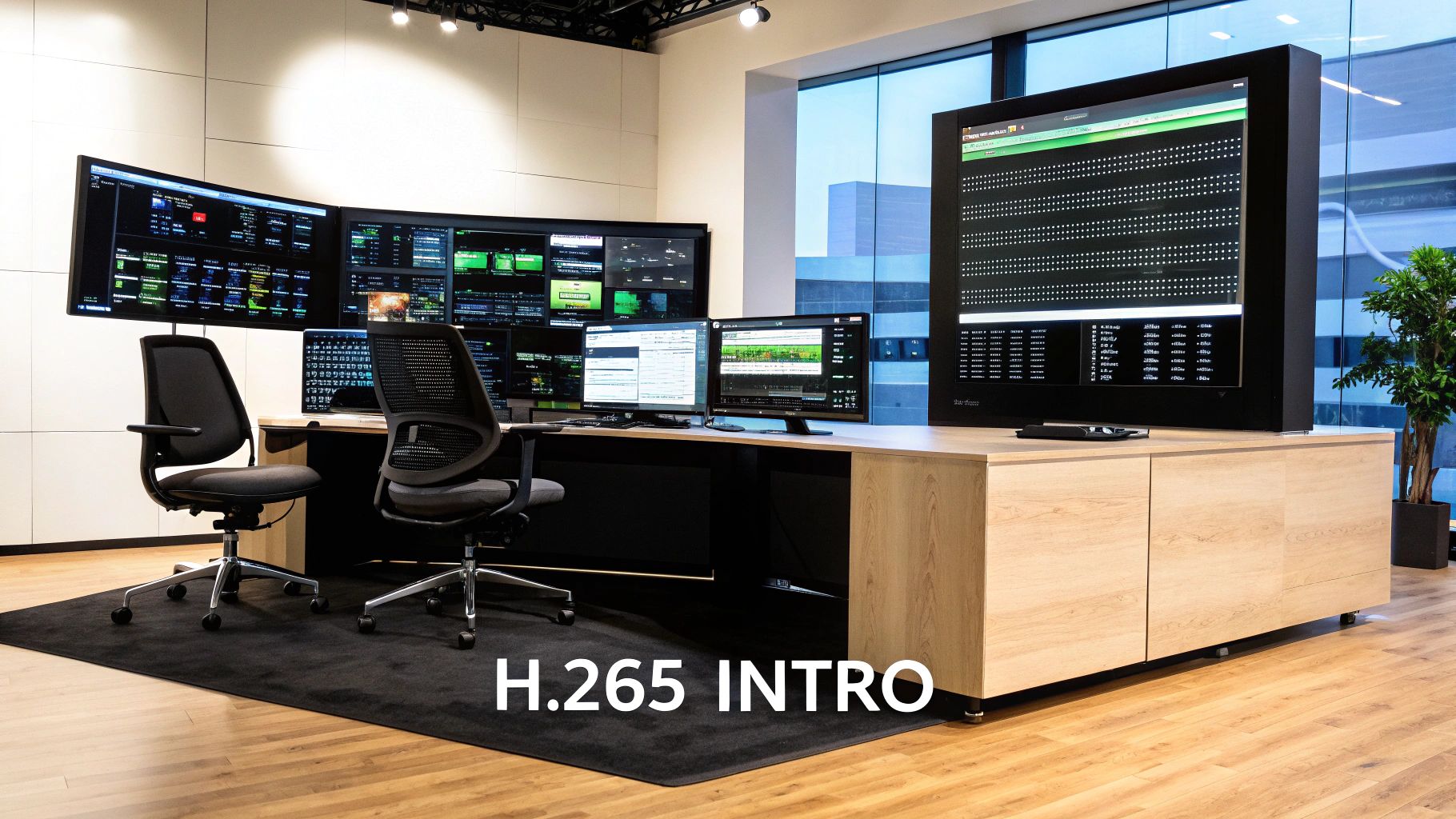H.265 Video Compression: The Ultimate Guide for Creators
Understanding H.265 Video Compression

From streaming 4K movies to experiencing immersive 8K VR, today's high-resolution video demands efficient file management. H.265 video compression, also known as High Efficiency Video Coding (HEVC), addresses this challenge. It has become essential for delivering quality video without straining bandwidth or storage.
H.265 works by maximizing the elimination of redundant data. Imagine packing a suitcase – you wouldn't bring duplicate items. H.265 operates similarly, identifying and discarding repeating visual information within and across video frames. This shrinking process dramatically reduces file size.
The H.265 standard, finalized in April 2013, represents a major upgrade from H.264. Designed for double the compression efficiency, H.265 delivers the same video quality at half the bit rate—or better quality at the same bit rate. This improvement is particularly impactful for 4K and 8K UHD video, minimizing bandwidth and storage needs without sacrificing picture quality. H.265 can reduce bit rate requirements by approximately 30%, making high-definition video streaming and storage more efficient. This has positioned H.265 as a leading standard for online video and broadcasting. However, licensing complexities and increased processing power requirements (compared to H.264) have presented adoption hurdles. For deeper insights into these statistics, see this article on VVC vs. H.265.
Key Improvements in H.265
Building on its predecessor (H.264), H.265 incorporates key advancements for superior compression. Let's explore some of the most significant:
-
Larger Coding Tree Units (CTUs): H.265 analyzes video in larger blocks (up to 64x64 pixels) than H.264. This allows for more efficient redundancy removal, especially in less detailed areas. Think of it as using larger puzzle pieces for simpler parts of an image.
-
Advanced Motion Prediction: H.265 employs sophisticated algorithms to predict movement between frames. By precisely predicting motion, it stores only the differences, significantly reducing data volume.
-
Improved Intra-Frame Prediction: H.265 uses a broader range of prediction modes for single-frame encoding, capturing static image details more effectively. This further minimizes redundancy within each frame.
These advancements result in a significant jump in compression performance. But the advantages extend beyond smaller file sizes. H.265 facilitates higher resolution video streaming and storage, shaping the future of how we experience visual content.
H.265 vs. H.264: What Actually Matters for Quality

Switching from H.264 to H.265 (also known as HEVC) offers big potential benefits when it comes to video compression. But what do these improvements really mean for video quality in everyday use? It's not simply about smaller files. It's about keeping, or even boosting, the quality of how your videos look while using less internet bandwidth. Let's break down the practical differences that are most important for both video creators and viewers.
Quantifying Bandwidth Savings and Quality
One of the biggest advantages of H.265 is its ability to deliver similar or even better video quality using much lower bitrates compared to H.264. This translates directly into saving bandwidth – a major plus for streaming platforms and anyone watching videos on a limited data plan.
For example, a 4K video encoded with H.264 might need a 32 Mbps bitrate for streaming. H.265 can achieve the same quality at around 15 Mbps, effectively cutting the bandwidth needed in half. This reduction becomes really important for delivering high-quality video, especially on networks where bandwidth is limited. Learn more about video codecs.
However, encoding with H.265 takes more processing power than H.264. This could be an issue for older devices or those with less processing capability. You might be interested in this comparison: H.264 vs H.265: A Detailed Comparison.
To illustrate the performance differences, let's take a look at the following table:
H.265 vs. H.264 Performance Metrics Comparative analysis of bitrate requirements and quality metrics between H.264 and H.265 across different resolutions
| Resolution | H.264 Bitrate (Mbps) | H.265 Bitrate (Mbps) | Bandwidth Savings (%) | Quality Comparison |
|---|---|---|---|---|
| 720p | 8 | 4 | 50 | Equivalent |
| 1080p | 16 | 8 | 50 | Equivalent or Better |
| 4K | 32 | 15 | 53 | Equivalent or Better |
As you can see, H.265 delivers significant bandwidth savings across different resolutions while maintaining or improving video quality. This makes it a compelling choice for modern video workflows.
Content-Specific Benefits
The benefits you get from H.265 also depend on what kind of video you're working with. For action-packed videos with lots of movement, H.265's improved motion prediction really stands out. It keeps things sharp and detailed even in fast-paced scenes, where H.264 might produce blur or visual artifacts.
Videos with lots of fine details, like nature documentaries or architecture tours, also benefit. H.265 excels at preserving textures and subtle color differences, even at lower bitrates.
Making Informed Encoding Decisions
Knowing these content-specific advantages lets creators choose the best encoding method for their videos. H.264 might work fine for lower resolution content or when bandwidth isn't a primary concern. However, H.265 is a game-changer for efficiently delivering high-resolution video.
Think about who your viewers are and how they typically watch your videos. If they're mainly watching on mobile devices with limited data, H.265 can significantly improve their viewing experience.
Practical Application for Video Workflows
Understanding how H.265 compression works allows creators to fine-tune their encoding settings for optimal results. Experimenting with different bitrates and quality settings helps find the perfect balance between file size and visual quality for different types of content. This can make a real difference in the overall quality of your delivered video, regardless of the viewing platform.
This ability to customize the encoding process empowers creators to maximize quality while using bandwidth efficiently. These improvements directly lower costs for streaming services, because they can provide the same viewing experience with less infrastructure expense. The ultimate goal is to give viewers the best possible quality without sacrificing efficiency.
How H.265 Video Compression Actually Works

Encoding video with H.265 can seem complicated, but grasping the fundamentals helps you fine-tune your settings for optimal results. This section explains how H.265, also known as High Efficiency Video Coding (HEVC), shrinks video file sizes without compromising quality. Understanding the core principles allows you to move beyond default presets and achieve better compression.
Identifying and Removing Redundancy
H.265 is exceptionally good at finding and eliminating redundant information. Imagine packing a suitcase—you wouldn't bring two identical shirts. H.265 works similarly, analyzing video frames to remove duplicate visual data within individual frames and across sequences of frames. This is the basis of its compression power.
For instance, if a large part of a frame shows a solid blue sky, H.265 stores the color data once and then references it across that area instead of storing the same data repeatedly.
Intelligent Predictions of Pixel Values
H.265 goes beyond simply removing exact duplicates. It also predicts pixel values. Using advanced motion prediction, it analyzes how objects move between frames. Instead of storing whole frames, H.265 records the changes in position and only the differences in pixel values, significantly reducing the data needed to represent motion.
Intra-frame prediction further enhances the encoding of static images within each frame. By employing a wider range of prediction modes, H.265 efficiently captures detail and reduces redundancy within each frame, shrinking the overall file size. Learn more in our article about how to compress videos using FFmpeg and an easier alternative.
The Power of Larger Coding Tree Units (CTUs)
A key advancement in H.265 is the use of larger coding tree units (CTUs), the fundamental building blocks of video analysis. H.265 uses CTUs up to 64x64 pixels, significantly larger than H.264's 16x16 pixel maximum. This allows H.265 to analyze larger video areas at once, improving redundancy removal, especially in areas with less detail.
Think about describing a large, plain wall. You wouldn't describe every single brick. You'd simply say "large, plain wall." CTUs allow H.265 to do something similar, treating large blocks of similar pixels as a single unit, minimizing required information.
Advanced Motion Compensation
H.265’s advanced motion compensation handles even complex movement efficiently, enhancing compression by predicting how objects move within the video. By accurately anticipating pixel movement in the next frame, H.265 only encodes the deviations from the predicted movement. This precision is vital for preserving video quality during fast action sequences, preventing blurring or other artifacts that can occur with less efficient compression methods. The combination of larger CTUs and advanced motion compensation ensures even complex movements are compressed effectively without sacrificing important visual information. This efficiency results in smaller file sizes and better streaming quality.
Real-World Benefits of H.265 Video Compression

H.265 video compression, also known as HEVC (High Efficiency Video Coding), offers significant practical advantages. Its influence is felt throughout the video world, from large studios to individual creators. This section explores the real-world benefits of H.265, using examples to illustrate its effectiveness.
Enhanced User Experience
One of the most obvious benefits of H.265 is the improved viewing experience. By shrinking file sizes considerably, H.265 allows videos to stream faster with significantly less buffering. Mobile users, for example, have seen a 67% reduction in buffering when watching H.265 videos compared to H.264.
This means smoother playback and a more enjoyable experience, especially on mobile networks with limited bandwidth. Improved user experience also means higher resolution videos, like 4K and 8K, can be streamed efficiently, making these formats accessible to more viewers.
Cost Savings for Content Providers
H.265 makes a big difference to the finances of content delivery networks (CDNs) and streaming services. The higher compression efficiency directly lowers bandwidth costs.
Some CDNs have reported 47% lower infrastructure costs after switching to H.265. This substantial cost saving is a major reason for the widespread adoption of H.265 within the industry. Smaller storage needs also contribute to these savings, allowing providers to handle bigger video libraries more effectively. You might be interested in: How to reduce file sizes.
Maintaining Creative Vision Under Constraints
For filmmakers and video creators, H.265 offers a way to maintain high visual quality even with limited bandwidth. This means creators can prioritize image quality without worrying about huge file sizes impacting distribution or viewer access.
The ability to deliver higher resolutions like 4K with manageable bitrates also opens up new artistic opportunities, enabling filmmakers to capture and share highly detailed visuals.
H.265: A Game-Changing Technology
In some cases, H.265 isn't just a small improvement—it's a game-changer. This technology has made projects possible that wouldn't have been feasible with older compression methods.
Live streaming 4K video from remote places with limited internet, for instance, becomes practical with H.265. This enables creators to film and share high-quality footage from anywhere, offering new opportunities for documentaries, live event broadcasting, and other applications.
The Future of Video Delivery
The advantages of H.265 go beyond current improvements in viewer experience and cost reduction. The technology plays a crucial role in the future of video delivery. As viewers increasingly want higher resolution and immersive video, efficient compression becomes even more vital.
H.265 lays the groundwork for this future, ensuring that high-quality video remains accessible and affordable as technology advances. This enables content providers to meet rising viewer expectations while keeping infrastructure costs sustainable.
Overcoming H.265 Implementation Challenges
While H.265, also known as High Efficiency Video Coding (HEVC), offers significant advantages, putting it into practice has presented some obstacles. This section explores these challenges and offers workable solutions.
Licensing Complexities
A major hurdle for H.265 adoption has been its intricate licensing structure. Unlike its predecessor H.264, H.265 involves multiple patent pools and associated fees. This creates a complicated situation for businesses, potentially requiring multiple agreements and increasing administrative work.
These licensing complexities can significantly impact budgets. Many organizations have found ways to manage these issues by carefully evaluating available licensing options and negotiating terms. Another approach is considering royalty-free codecs like AV1, especially when budget is a primary concern. For a deeper look into compression and royalty-free alternatives to H.265 like AV1, explore this resource.
Hardware Demands
H.265 achieves greater compression by requiring more processing power for both encoding and decoding. This can be problematic for older or less powerful devices. In some cases, hardware upgrades may be necessary to fully support H.265.
One solution is hybrid encoding. This approach involves encoding video in both H.264 and H.265 formats. Older devices can then play the H.264 version, while newer devices benefit from the efficiency of H.265. This strategy expands compatibility without compromising quality for users with capable hardware.
Compatibility Concerns
Seamless playback across a range of devices and browsers is essential. However, H.265 support isn't universal. This lack of compatibility can lead to viewer frustration and limit broader adoption.
Addressing this requires comprehensive testing across various devices, operating systems, and browsers. Identifying potential problems early allows for proactive solutions. Providing H.264 alternatives as a fallback ensures a smooth viewing experience for all users, regardless of their setup.
A Strategic Approach
Successful H.265 implementation demands a well-defined strategy. Consider your budget, target audience, and existing technical infrastructure. If licensing costs are a major factor, explore royalty-free codecs like AV1, or thoroughly negotiate licensing agreements. For hardware limitations, consider using hybrid encoding.
Prioritize extensive testing and fallback mechanisms to address compatibility. By proactively tackling these challenges, you can maximize the benefits of H.265 video compression and deliver high-quality video to a wide audience.
To summarize common H.265 implementation challenges and their solutions, take a look at the table below:
Table: H.265 Implementation Challenges & Solutions
| Challenge | Impact | Solution | Implementation Complexity |
|---|---|---|---|
| Licensing Complexity | Increased costs, administrative overhead | Negotiate favorable licensing terms, explore royalty-free codecs like AV1 | Medium to High |
| Hardware Demands | Increased processing power requirements, potential hardware upgrades | Hybrid encoding, hardware upgrades | Medium |
| Compatibility Concerns | Playback issues on certain devices/browsers, viewer frustration | Thorough testing, fallback mechanisms (H.264 alternative) | Low to Medium |
This table highlights the potential hurdles in adopting H.265, but also provides practical solutions to ensure a successful implementation. Balancing cost, performance, and compatibility is key to harnessing the power of H.265 effectively.
H.265 In The Evolving Compression Landscape
H.265, also known as HEVC (High Efficiency Video Coding), has significantly improved video compression. But technology never stands still. This section looks at how H.265 compares to newer codecs like H.266/VVC, AV1, and LCEVC, helping you choose the right video compression strategy.
H.266/VVC: The Next Generation
H.266/VVC (Versatile Video Coding) follows H.265, offering even better compression. It delivers roughly 40% better compression than H.265 at the same visual quality. This translates to lower bandwidth needs for streaming and smaller files for storage, especially important for 8K video and higher resolutions. However, the higher processing power needed for encoding and decoding makes wider adoption a challenge.
AV1: The Royalty-Free Contender
AV1, developed by the Alliance for Open Media, is a royalty-free codec and a strong H.265 alternative. Its compression is similar to H.265, but the lack of licensing fees makes it appealing for content creators and platforms. AV1 is gaining popularity, especially in web browsers and some streaming services. However, hardware support is still developing.
LCEVC: Enhancing Existing Codecs
LCEVC (Low Complexity Enhancement Video Coding) takes a unique approach, improving existing codecs like H.264 and H.265 instead of replacing them. It adds an enhancement layer to the main video stream, boosting quality and enabling features like HDR (High Dynamic Range). This approach ensures compatibility with older devices while providing performance improvements on newer hardware.
Industry Adoption Trends
Different industries are adopting these codecs at different speeds. Broadcasters are exploring H.266 for 8K content, while streaming platforms test AV1 to lower costs. Hardware makers are gradually adding H.266 and AV1 support to new devices. LCEVC is gaining ground because it improves existing workflows and systems.
AI-Enhanced Encoding: A New Frontier
Artificial intelligence is becoming more important in video encoding. AI-powered tools can fine-tune compression for different content, improving efficiency and quality. These tools can also adapt to varying network conditions and device capabilities, providing the best viewing experience across platforms.
Practical Timelines for Technology Transitions
Switching to new codecs requires careful planning. H.266 offers significant advantages, but widespread use will take time due to hardware and software needs. AV1 is easier to deploy because it's royalty-free, but broader hardware support is still growing. LCEVC offers a faster route to better quality using existing infrastructure. The best choice depends on your specific needs and the changing video compression landscape.
Navigating The Evolving Landscape
Video compression is constantly evolving. A solid content strategy means understanding current codec performance, adoption trends, and new technologies. Regularly assess your needs and how different codecs fit your long-term goals. This proactive approach ensures you deliver top video quality while adapting to technological changes.
Ready to simplify your video workflow and boost efficiency? Try Compresto, the ultimate file compression tool for macOS. Explore Compresto now!